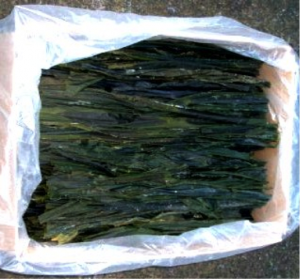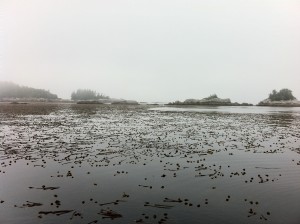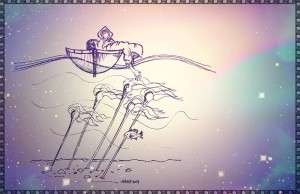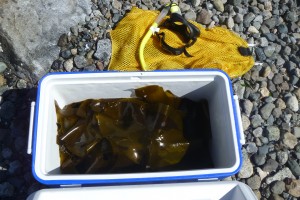Kelps are large brown seaweeds that thrive in nutrient rich temperate marine ecosystems. These giant seaweeds create underwater forests that are hubs for diversity and support many marine organisms by providing protection and food.
Kelp is important in shaping marine habitat, but it is also involved in our daily lives! It is used in a wide variety of products including food, fertilizer, animal food, medicines, toothpaste, cosmetics and even biofuel (SINTEF, 2011).
OK, so kelp forms important marine ecosystems and it’s in everything, but where are we getting it all from? Kelp and kelp products come from kelp farming. Kelp farming includes both the harvesting of kelp from wild populations as well as the culturing and harvesting of kelp.
Some have praised seaweed and kelp farming as being the least detrimental form of aquaculture (Folke et al., 1998), but does this mean it’s a good idea to farm kelp?
Kelp harvesting has been shown to not effect production of juvenile or growth of adult South African kelp, and has no effect on diversity of invertebrates associated with the kelp, even when under high harvesting pressure (Rothman, 2006, Vásquez et al., 2012). However, research has also found that severe harvesting is decreasing wild kelp populations and overharvesting increases the chances of local extinction of the harvested kelp species (Vega et al., 2014; Vásquez et al., 2012; Wootton and Pfister, 2013). Many dislike large-scale kelp harvesting because of this risk. However, if kelp harvesting is strongly regulated as to what species are harvested, when and where they are harvested, and how they are harvested, overexploitation can be avoided and wild kelp populations can continue to flourish (Vásquez et al., 2012).
So what’s the verdict on kelp cultivation? Kelp cultivation has its benefits; it requires little or no additions of fertilizers or antibiotics (Bryceson, 2002; Johnstone and Ólafsson, 1995). Research has shown that kelp cultivation paired with fish aquaculture serves as a great way to decrease overall waste production of fish farming to lower the environmental impact because seaweeds are able to use the waste as a source of nutrients (Bourne, 2014). Although kelp cultivation seems to have some good qualities, but there has not been a consensus reached on the environmental impacts of large-scale cultivation (Buschmann, et al., 2014). The major concerns are if kelp aquaculture will modify interactions among local species, if the farms will increase the likelihood of disease outbreaks in nearby wild kelp populations and if the kelp farms would use up all of the nutrients previously available to wild marine photosynthesizers (Buschmann, et al., 2014). It has been documented that kelp aquaculture can have negative impacts on wild species interactions (Bryceson, 2002), but little is known about the impacts large-scale cultivation could have (Andrews, 1976; Buschmann, et al., 2014; Gachon et al., 2010). This makes it difficult to come to a conclusion about kelp cultivation when little is known about the environmental impacts. I prefer to err on the side of caution and would like to see more research published on the long-term impacts of kelp cultivation before I make a decision to support or oppose kelp cultivation.
Work Cited
Andrews, J. H. (1976). The pathology of marine algae. Biology Review 51: 211–253.
Bourne, J.K. (2014) How to farm a better fish. National geographic 225 (6): 92-111.
Buschmann, A.H., Prescott, S., Potin, P., Faugerson, S., Vásquez, J.A., Camus, C., Infante, J., Hernández-González, M.C., Gutierrez, A., and Varela, D.A. (2014) Sea plants the status of kelp exploitation and marine agronomy with emphasis on Marcosystis pyrifera, in Chile. Advances in Botanical Research 71: 161- 188.
Bryceson, I. (2002) Coastal aquaculture developments in Tanzania: sustainable and non-sustainable experiences. West Indian Ocean Journal of Marine Science 1(1):1-10.
Folke, C., Kautsky, N., Berg, H., Jansson, A., and Troell, M. (1998) The ecological footprint concept for sustainable seafood production: a review. Ecological Application 8: S63-S71.
Gachon, C. M., Sime-Ngando, T., Strittmatter, M., Chambouvet, A., and Kim, G. H. (2010) Algal diseases: spotlight on a black box. Trends in Plant Science 15: 633 – 640.
Johnstone, R. and Ólafsson, E. (1995) Some environmental aspects of open water algal cultivation: Zanzibar, Tanzania. Ambio 24: 465-469.
Rothman, M.D. (2006) The effects of harvesting of South African kelp (Ecklonia maxima) on kelp population structure, growth rate and recruitment. Journal of Applied Phycology 18 (3-5): 335 – 341.
SINTEF. “Kelp farming is on its way.” ScienceDaily. ScienceDaily, 30 August 2011. <www.sciencedaily.com/releases/2011/08/110830101604.htm>.
Vásquez, J.A., Piaget, N., and Vega, J.M. (2012) The Lessonia nigrescens fishery in northern Chile: “how you harvest is more important than how much you harvest.” Journal of Applied Phycology 24:417 – 426.
Vega, J.M.A., Broitman, B., and Vásquez, J.A. (2014) Monitoring the sustainability of Lessonia nigrescens complex (Laminariales, Phaeophyta) in northern Chile under strong harvest pressure. Journal of Applied Phycology 24:417–426.
Wootton, J.T. and Pfister, C.A. (2013) Experimental separation of genetic and demographic factors on extinction risk in wild populations. Ecology 94: 2117–2123.



